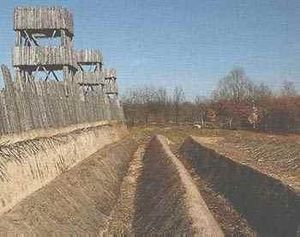
Back Slag van Alesië Afrikaans معركة أليزيا Arabic Alesia savaşı Azerbaijani آلیزیا دؤیوشو AZB Schlocht vo Alesia BAR Битка при Алезия Bulgarian Emgann Alesia Breton Batalla d'Alèsia Catalan Bitva o Alesii Czech Brwydr Alesia Welsh
You can help expand this article with text translated from the corresponding article in French. Click [show] for important translation instructions.
|
| Battle of Alesia | |||||||||
|---|---|---|---|---|---|---|---|---|---|
| Part of the Gallic Wars | |||||||||
 A reconstructed section of the Alesia investment fortifications | |||||||||
| |||||||||
| Belligerents | |||||||||
| Roman Republic | Gallic confederation | ||||||||
| Commanders and leaders | |||||||||
|
Julius Caesar Mark Antony Titus Labienus Gaius Trebonius |
Vercingetorix Vercassivellaunos Sedullos † Commius Mediomatrici | ||||||||
| Strength | |||||||||
|
10–11 legions[1][2] (30–50,000 legionaries) 60,000–75,000 approx. total Romans and allies |
328,000–470,000 total (ancient sources)[a]
<70,000–180,000 total (modern est.)[7][8]
| ||||||||
| Casualties and losses | |||||||||
| 12,800 killed and wounded[9] |
290,000 (Caesar, exaggerated)[9]
| ||||||||
The Battle of Alesia or siege of Alesia (September 52 BC) was the climactic military engagement of the Gallic Wars, fought around the Gallic oppidum (fortified settlement) of Alesia in modern France, a major centre of the Mandubii tribe. It was fought by the Roman army of Julius Caesar against a confederation of Gallic tribes united under the leadership of Vercingetorix of the Arverni. It was the last major engagement between Gauls and Romans, and is considered one of Caesar's greatest military achievements and a classic example of siege warfare and investment; the Roman army built dual lines of fortifications—an inner wall to keep the besieged Gauls in, and an outer wall to keep the Gallic relief force out. The Battle of Alesia marked the end of Gallic independence in the modern day territory of France and Belgium.
The battle site was probably atop Mont Auxois, above modern Alise-Sainte-Reine in France, but this location, some have argued, does not fit Caesar's description of the battle. A number of alternatives have been proposed over time, among which only Chaux-des-Crotenay (in Jura in modern France) remains a challenger today.[10]
The event is described by Caesar himself in his Commentarii de Bello Gallico as well as several later ancient authors (namely Plutarch and Cassius Dio). After the Roman victory, Gaul (very roughly modern France) was subdued, although Gallic territories north of Gallia Narbonensis would not become a Roman province until 27 BC. The Roman Senate granted Caesar a thanksgiving of 20 days for his victory in the Gallic War.[11]
- ^ a b Dodge, Theodore Ayrault (1989–1997). Caesar. New York. pp. 276–295.
{{cite book}}: CS1 maint: location missing publisher (link) - ^ Keppie, Lawrende (1998). The making of the roman army. University of Oklahoma. p. 97. ISBN 9780415151504.
{{cite book}}: CS1 maint: location missing publisher (link) - ^ Julius Caesar, Commentarii de Bello Gallico 7.71
- ^ Julius Caesar, Commentarii de Bello Gallico 7.76
- ^ Plutarch, Parallel Lives, Life of Caesar, 27, 3.
- ^ Strabo, Geographica, IV, 2, 3
- ^ Cite error: The named reference
Hans Delbrückwas invoked but never defined (see the help page). - ^ "Caesar's Grand Siege at Alesia". Warfare History Network. Retrieved 2023-09-19.
- ^ a b Kennedy Hickman (13 January 2019). "Gallic Wars: Battle of Alesia". ThoughtCo. Retrieved 21 June 2019.
- ^ "Alésia Mandubiorum l'Hypothèse jurassienne" (in French). Archived from the original on July 20, 2011. Retrieved May 9, 2011.
- ^ Julius Caesar, Commentarii de Bello Gallico 7.90
Cite error: There are <ref group=lower-alpha> tags or {{efn}} templates on this page, but the references will not show without a {{reflist|group=lower-alpha}} template or {{notelist}} template (see the help page).